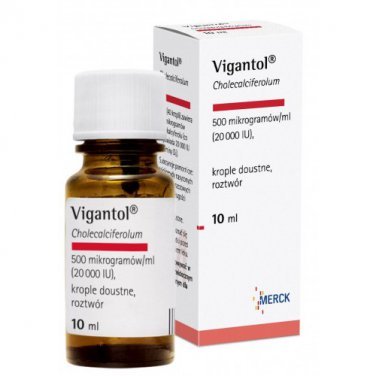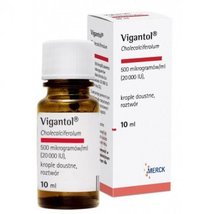Rendered at 08:00:46 08/18/25
Free Shipping
Vigantol Vitamin D3,Drops 10 ML.(PACK OF 4 )
$59.99
Ships from
Bulgaria

Shipping options
Estimated to arrive by Mon, Sep 15th.
Details
FREE via International Shipping (3 to 4 weeks) to United States
Ships from
Bulgaria

Offer policy
OBO - Seller accepts offers on this item.
Details
Return policy
Full refund available within 30 days
Purchase protection
Payment options
PayPal accepted
PayPal Credit accepted
Venmo accepted
PayPal, MasterCard, Visa, Discover, and American Express accepted
Maestro accepted
Amazon Pay accepted
Nuvei accepted
Shipping options
Estimated to arrive by Mon, Sep 15th.
Details
FREE via International Shipping (3 to 4 weeks) to United States
Ships from
Bulgaria

Offer policy
OBO - Seller accepts offers on this item.
Details
Return policy
Full refund available within 30 days
Purchase protection
Payment options
PayPal accepted
PayPal Credit accepted
Venmo accepted
PayPal, MasterCard, Visa, Discover, and American Express accepted
Maestro accepted
Amazon Pay accepted
Nuvei accepted
Item traits
| Category: | |
|---|---|
| Quantity Available: |
19 in stock |
| Condition: |
New |
| UPC: |
300858U3HWJI |
| Brand: |
Chattanooga |
| MPN: |
300858U3HWJI |
| Country/Region of Manufacture: |
United States |
Listing details
| Seller policies: | |
|---|---|
| Shipping discount: |
Seller pays shipping for this item. |
| Price discount: |
10% off w/ $200.00 spent |
| Posted for sale: |
More than a week ago |
| Item number: |
1600865027 |
Item description
Read all of this leaflet carefully before you start using this medicine because it contains important information for you.
Keep this leaflet. You may have to read it again.
If you have any further questions, ask your doctor or pharmacist.
This medicine has been prescribed for you. Don't pass it on to other people. It can harm them, even if their symptoms are the same as yours.
If any of the side effects gets serious, or if you notice any side effects not listed in this leaflet, please tell your doctor or pharmacist. See section 4.
What is in this leaflet
1. What Vigantol is and what it is used
for 2. What you need to know before you take Vigantol
3. How to take Vigantol
4. Possible side effects
5. How to store Vigantol
6. Contents of the pack and other information
1. What Vigantol is and what it is used for
Vigantol is a vitamin preparation: Vigantol contains cholecalciferol (cholecalciferol) (corresponds to vitamin D.V).
Vigantol is used for:
Prevention of rickets and osteomalacia in children and adults
Prevention of rickets in premature babies
Prevention of vitamin D deficiency in children and adults at identified risk
Prevention of vitamin D deficiency in children and adults with malabsorption, e.g. due to chronic intestinal diseases, cirrhosis of the liver, extensive resection of the gastrointestinal tract
Treatment of rickets and osteomalacia induced by vitamin D deficiency in children and adults
Treatment of hypoparathyroidism and pseudohypoparathyroidism in adults
Maintenance treatment of osteoporosis in adults
2. What you need to know before you use Vigantol
Do not take Vigantol
• if you are allergic (hypersensitive) to cholecalciferol or any of the other ingredients of Vigantol;
if you have hypercalcaemia (increased concentration of calcium in your blood);
if you have hypercalciuria (increased concentration of calcium in your urine);
Take special care with Vigantol
with increased calcium content in the blood and / or urine;
when treated with benzothiadiazine derivatives (medicinal preparations stimulating urine output);
during pregnancy;
if you suffer from sarcoidosis, because there is a risk of increased absorption of vitamin D3 and its active form. In this case, you need to monitor the level of calcium in the blood and urine.
In patients with limited renal function leading to kidney stones, the level of calcium in the blood and urine should be monitored.
when taking additional amounts of vitamin D with other medicinal products
With pseudohypoparathyroidism, particular attention should be paid to signs of intoxication and take into account that phases of normal sensitivity to vitamin D are possible, so the requirement is reduced accordingly.
Use of other medicines
Please tell your doctor or pharmacist if you are taking or have recently taken any other medicines, including medicines obtained without a prescription.
Phenytoin (for the treatment of epilepsy) and barbiturates (for the treatment of epilepsy and insomnia, as well as for anesthesia) may reduce the effect of vit. D3.
Concomitant use of glucocorticosteroids may reduce the effect of vit. D3
Concomitant administration with cardiac glycosides (stimulating heart muscle) may increase their toxicity due to an increase in the level of calcium in the blood. In these patients, cardiac activity should be monitored by an ECG and the level of calcium in the blood and urine examined.
Concomitant use of thiazide diuretics (e.g. benzothiadiazine derivatives) administered to stimulate urine output may increase the risk of hypercalcaemia (increased blood calcium concentration). Therefore, with prolonged treatment, the level of calcium in the blood and urine should be monitored.
If other preparations containing vitamin D3 are prescribed, the dose of vitamin D3 in Vigantol should be taken into account. Additional intake of vitamin D or calcium should be done only under medical supervision. In these cases, the level of calcium in the blood and urine should be monitored.
Rifampicin and isoniazid (bactericidal antibiotics): may increase vitamin D metabolism and reduce its effectiveness.
Pregnancy, breast-feeding and fertility
During pregnancy, sufficient intake of vitamin D is necessary.
Consult your doctor or pharmacist for advice before taking any medications.
During pregnancy, Vigantol should be given only for strictly defined symptoms and dosed as it is mandatory to eliminate the deficiency. During pregnancy, prolonged overdose of vitamin D should be avoided because it can lead to hypercalcaemia (increased concentration of calcium in the blood), which in turn can lead to physical and mental disabilities, as well as congenital heart disease of the child.
Vitamin D and its products pass into breast milk. No overdose induced by breast milk alone was observed.
Driving and using machines
There is no need to take special precautions.
3. How to take Vigantol
Always take Vigantol exactly as your doctor or pharmacist has told you. Check with your doctor or pharmacist if you are not sure.
Hold the Vigantol bottle downside down in a vertical position.
It will take some time for the first drop to appear.
Use in newborns and infants should only be carried out under the supervision of a doctor. Do not exceed the indicated dose.
Unless otherwise prescribed, the usual dose is:
Prevention of rickets in infants: 1 drop daily Vigantol (approximately 500 IU vitamin D3), premature infants: 2 drops daily Vigantol
(approximately 1000 IU vitamin D3)
Infants receive Vigantol from the second week after birth until the end of their first year. Additional doses of Vigantol are recommended in the second year of their birth, especially during the winter months.
Drops are given with a spoonful of milk or food. If the drops are added to a bottle or spoonful of food, care should be taken to consume the food in full, as otherwise the full dose will not be taken.
Treatment of rickets and osteomaladia induced by vitamin D deficiency:
2-10 drops daily Vigantol (approximately 1000 to 5000 IU vitamin D3 ). Treatment should last a year.
Maintenance treatment of osteoporosis: 2-6 drops daily Vigantol (approximately 1000-3000 IU vitamin D3).
Prevention at suspected risk of vitamin D deficiency disease: 1-2 drops daily Vigantol (approximately 500-1000IU vitamin D3).
Malabsorption prevention: 6-10 drops per day of Vigantol (equivalent to 3000-5000 IU of vitamin D3).
Treatment of hypoparathyroidism and pseudohypoparathyroidism: recommended doses are from 10,000 to 200,000 IU of vitamin D daily. Depending on serum calcium levels, the daily dose is 20-40 drops (equivalent to 10,000 - 20,000 IU of vitamin D3). If higher doses are required, it is advisable to administer forms with higher doses. Calcium levels in urine and blood should be checked initially every 4-6 weeks and then every 3-6 months, with the dose adjusted to these levels.
If you take more Vigantol than you should
In infants, concomitant use of foods and other products or medications containing vitamin D should be avoided. If in doubt, your doctor will decide whether additional use of foods fortified with vitamins or foods and additional medications containing vitamin D is appropriate. Prolonged overdose of vitamin D
may lead to a risk of hypercalcaemia (increased concentration of calcium in the blood) and hypercalciuria (increased concentration of calcium in the urine).
With an overdose, hypercalcaemia syndrome (increased concentration of calcium in the blood) occurs, and later to the excretion of calcium in the tissues, and mainly in the kidneys (kidney stones and renal calcium formations) and in the vessels.
Symptoms of overdose are not very characteristic and are expressed in loss of appetite, headache, vomiting, nausea, constipation (constipation), increased thirst, increased urine output, muscle weakness, adinamy (decreased motor activity), dehydration (dehydration). Typical laboratory conclusions are hypercalcaemia (increased concentration of calcium in the blood) and hypercalciuria (increased concentration of calcium in the urine), as well as increased serum values of 25-hydroxycalciferol.
In case of overdose, measures should be taken to treat frequently prolonged and, in certain circumstances, dangerous hypercalcaemia (increased concentration of calcium in the blood).
For long-term use of daily doses exceeding 1000 IU of vitamin D, serum calcium levels should be investigated, especially in newborns and infants who may respond more sensitively to high doses.
Added to your wish list!

- Vigantol Vitamin D3,Drops 10 ML.(PACK OF 4 )
- 19 in stock
- Price negotiable
- Handling time 1 day. Estimated delivery: Mon, Sep 15th
- Returns/refunds accepted
Get an item reminder
We'll email you a link to your item now and follow up with a single reminder (if you'd like one). That's it! No spam, no hassle.
Already have an account?
Log in and add this item to your wish list.
















